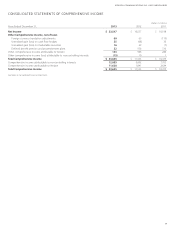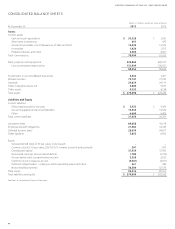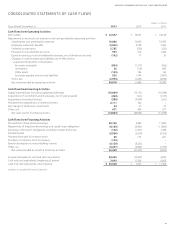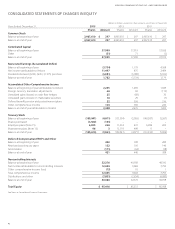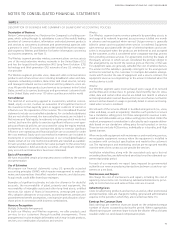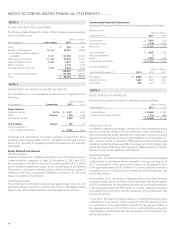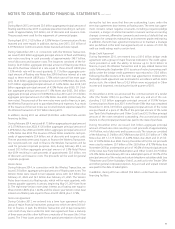Verizon Wireless 2013 Annual Report Download - page 47
Download and view the complete annual report
Please find page 47 of the 2013 Verizon Wireless annual report below. You can navigate through the pages in the report by either clicking on the pages listed below, or by using the keyword search tool below to find specific information within the annual report.45
NOTES TO CONSOLIDATED FINANCIAL STATEMENTS continued
Deferred income taxes are provided for temporary dierences in the
bases between nancial statement and income tax assets and liabili-
ties. Deferred income taxes are recalculated annually at tax rates then in
eect. We record valuation allowances to reduce our deferred tax assets
to the amount that is more likely than not to be realized.
We use a two-step approach for recognizing and measuring tax benets
taken or expected to be taken in a tax return. The rst step is recognition:
we determine whether it is more likely than not that a tax position will be
sustained upon examination, including resolution of any related appeals
or litigation processes, based on the technical merits of the position. In
evaluating whether a tax position has met the more-likely-than-not rec-
ognition threshold, we presume that the position will be examined by
the appropriate taxing authority that has full knowledge of all relevant
information. The second step is measurement: a tax position that meets
the more-likely-than-not recognition threshold is measured to determine
the amount of benet to recognize in the nancial statements. The tax
position is measured at the largest amount of benet that is greater than
50 percent likely of being realized upon ultimate settlement. Dierences
between tax positions taken in a tax return and amounts recognized in
the nancial statements will generally result in one or more of the fol-
lowing: an increase in a liability for income taxes payable, a reduction of
an income tax refund receivable, a reduction in a deferred tax asset, or an
increase in a deferred tax liability.
The accounting standard relating to income taxes generated by lever-
aged lease transactions requires that changes in the projected timing of
income tax cash ows generated by a leveraged lease transaction be rec-
ognized as a gain or loss in the year in which the change occurs.
Signicant management judgment is required in evaluating our tax posi-
tions and in determining our eective tax rate.
Stock-Based Compensation
We measure and recognize compensation expense for all stock-based
compensation awards made to employees and directors based on esti-
mated fair values. See Note 10 for further details.
Foreign Currency Translation
The functional currency of our foreign operations is generally the local
currency. For these foreign entities, we translate income statement
amounts at average exchange rates for the period, and we translate
assets and liabilities at end-of-period exchange rates. We record these
translation adjustments in Accumulated other comprehensive income,
a separate component of Equity, in our consolidated balance sheets.
We report exchange gains and losses on intercompany foreign currency
transactions of a long-term nature in Accumulated other comprehensive
income. Other exchange gains and losses are reported in income.
Employee Benet Plans
Pension and postretirement health care and life insurance benefits
earned during the year as well as interest on projected benet obliga-
tions are accrued currently. Prior service costs and credits resulting
from changes in plan benets are generally amortized over the average
remaining service period of the employees expected to receive benets.
Expected return on plan assets is determined by applying the return on
assets assumption to the actual fair value of plan assets. Actuarial gains
and losses are recognized in operating results in the year in which they
occur. These gains and losses are measured annually as of December
31 or upon a remeasurement event. Verizon management employees
no longer earn pension benets or earn service towards the company
retiree medical subsidy (see Note 11).
We recognize a pension or a postretirement plan’s funded status as either
an asset or liability on the consolidated balance sheets. Also, we measure
any unrecognized prior service costs and credits that arise during the
period as a component of Accumulated other comprehensive income,
net of applicable income tax.
macroeconomic conditions (including changes in interest rates and
discount rates), industry and market considerations (including industry
revenue and EBITDA (Earnings before interest, taxes, depreciation and
amortization) margin projections), the projected nancial performance
of Wireless, as well as other factors. In 2012 and 2011, our quantitative
assessment consisted of comparing the estimated fair value of our wire-
less licenses to the aggregated carrying amount as of the test date. Using
the quantitative assessment, we evaluated our licenses on an aggregate
basis using a direct value approach. The direct value approach estimates
fair value using a discounted cash ow analysis to estimate what a mar-
ketplace participant would be willing to pay to purchase the aggregated
wireless licenses as of the valuation date. If the fair value of the aggre-
gated wireless licenses is less than the aggregated carrying amount of
the licenses, an impairment is recognized.
Interest expense incurred while qualifying activities are performed to
ready wireless licenses for their intended use is capitalized as part of
wireless licenses. The capitalization period ends when the development
is discontinued or substantially complete and the license is ready for its
intended use.
Intangible Assets Subject to Amortization and Long-Lived Assets
Our intangible assets that do not have indenite lives (primarily customer
lists and non-network internal-use software) are amortized over their esti-
mated useful lives. All of our intangible assets subject to amortization
and long-lived assets are reviewed for impairment whenever events or
changes in circumstances indicate that the carrying amount of the asset
may not be recoverable. If any indications were present, we would test
for recoverability by comparing the carrying amount of the asset group
to the net undiscounted cash ows expected to be generated from the
asset group. If those net undiscounted cash ows do not exceed the car-
rying amount, we would perform the next step, which is to determine
the fair value of the asset and record an impairment, if any. We reevaluate
the useful life determinations for these intangible assets each year to
determine whether events and circumstances warrant a revision in their
remaining useful lives.
For information related to the carrying amount of goodwill by segment,
wireless licenses and other intangible assets, as well as the major com-
ponents and average useful lives of our other acquired intangible assets,
see Note 3.
Fair Value Measurements
Fair value of nancial and non-nancial assets and liabilities is dened
as an exit price, representing the amount that would be received to sell
an asset or paid to transfer a liability in an orderly transaction between
market participants. The three-tier hierarchy for inputs used in measuring
fair value, which prioritizes the inputs used in the methodologies of mea-
suring fair value for assets and liabilities, is as follows:
Level 1 – Quoted prices in active markets for identical assets or liabilities
Level 2 – Observable inputs other than quoted prices in active markets
for identical assets and liabilities
Level 3 – No observable pricing inputs in the market
Financial assets and nancial liabilities are classied in their entirety based
on the lowest level of input that is signicant to the fair value measure-
ments. Our assessment of the signicance of a particular input to the fair
value measurements requires judgment, and may aect the valuation of
the assets and liabilities being measured and their placement within the
fair value hierarchy.
Income Taxes
Our eective tax rate is based on pre-tax income, statutory tax rates, tax
laws and regulations and tax planning strategies available to us in the
various jurisdictions in which we operate.






